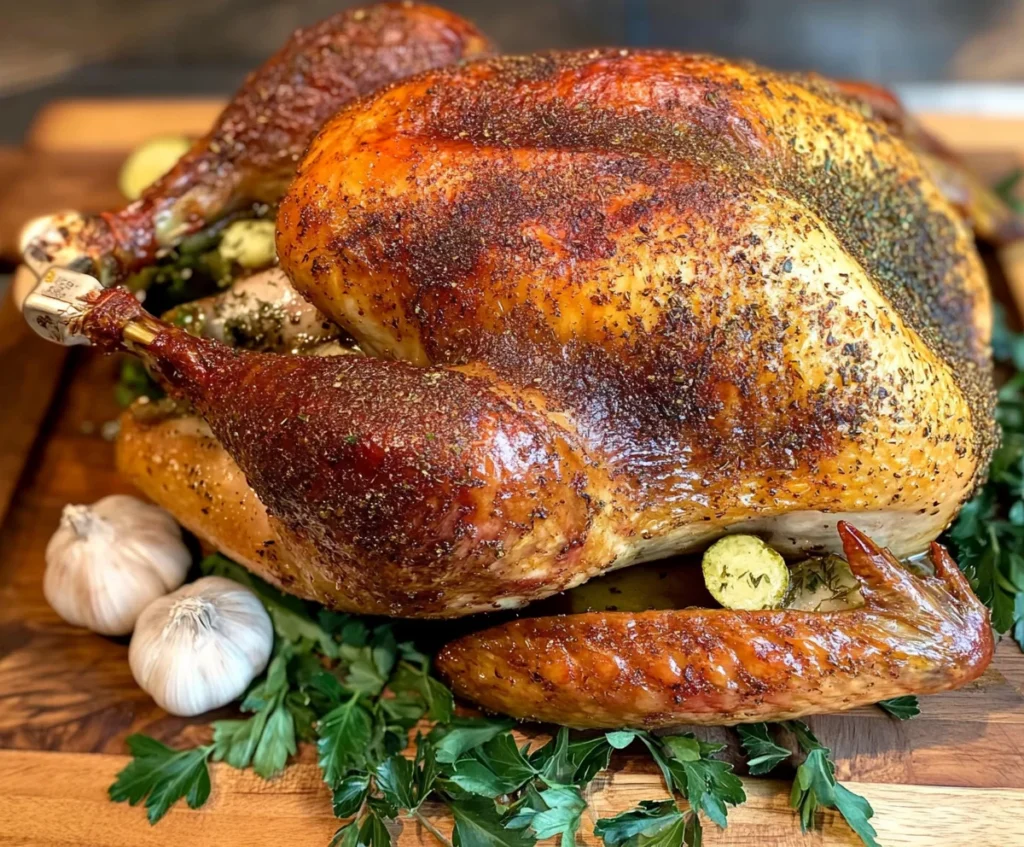When it comes to preparing a turkey that’s juicy, moist, and full of flavor, a turkey injection recipe is your secret weapon. Whether you’re hosting a holiday feast or cooking outdoors for a backyard gathering, injecting marinade directly into the turkey meat guarantees that every bite bursts with flavor.
In this guide, we’ll break down everything you need to know about turkey injections: why they work, how to prepare and inject your turkey, flavor variations, cooking tips, and common mistakes to avoid.
What is a Turkey Injection Recipe?
A turkey injection recipe involves using a marinade syringe to inject a flavorful liquid mixture deep into the turkey’s muscle tissues. Unlike surface seasoning or brining, injecting allows flavor and moisture to be evenly distributed throughout the entire bird—especially in the dense breast and thigh areas.
How It Works
Injection uses pressure to infuse the turkey with a marinade, often made with broth, butter, herbs, spices, and sometimes citrus juice or vinegar. This helps tenderize the meat while enhancing natural flavors.
Why Use a Turkey Injection Recipe?
1. Keeps the Turkey Moist
Turkey, especially the breast, can become dry during cooking. Injecting the meat helps lock in moisture from the inside, keeping it juicy and preventing it from drying out during cooking.
2. Infuses Deep Flavor
While surface seasoning and brining only reach the outer layers, an injection delivers flavor throughout the entire bird, from the inside out.
3. Saves Time
Unlike traditional marinades that need hours to soak, injected turkey can be cooked immediately or after a short resting period.
4. Customizable Flavors
You can create a custom blend for any flavor profile—from savory garlic herb to spicy Cajun or sweet and tangy citrus blends.
Essential Ingredients for a Turkey Injection Recipe
Butter or Oil
Acts as a rich base that helps the marinade adhere to and penetrate the meat. Use unsalted butter for control over salt levels, or flavored butter for added depth.
Broth
Chicken, turkey, or vegetable broth enhances umami and provides a savory foundation for other flavors.
Apple Cider Vinegar
Adds brightness and acidity, which helps tenderize the meat and balance heavier ingredients like butter.
Citrus Juices
Lemon, orange, or lime juices are perfect for a refreshing, zesty profile that cuts through the richness of the turkey.
Garlic and Herbs
Use fresh or powdered garlic, thyme, rosemary, and sage to add aromatic layers and earthy complexity.
Salt and Pepper
Salt enhances the flavor of all other ingredients, while black pepper provides mild heat and balance.
Sweeteners
Brown sugar or honey complements salty and spicy elements, adding a subtle sweetness and depth.
How to Prepare Your Turkey for Injection
Step 1: Thaw Completely
Ensure your turkey is fully thawed. A frozen center won’t absorb the marinade evenly and may cook unevenly.
Step 2: Clean and Trim
Take out the giblets and neck, give the turkey a good rinse inside and out, then dry it thoroughly with paper towels. Trim excess fat or loose skin.
Step 3: Set Up on a Stable Surface
Place the turkey breast-side up on a large tray or board. Use a roasting rack if desired, and make sure it’s stable for easy injecting.
How to Inject a Turkey
Step 1: Prepare the Syringe
Load your marinade syringe with a smooth, well-strained liquid to ensure it flows easily and doesn’t clog. Avoid chunks that can clog the needle. Draw a manageable amount per injection to avoid leakage.
Step 2: Inject the Breast
Insert the needle deep into multiple spots across the breast, injecting a small amount each time. Move the needle slightly between pushes to distribute the marinade evenly.
Step 3: Inject the Thighs and Drumsticks
These areas are denser and require more marinade. Inject into the thickest parts and angle the needle in various directions.
Step 4: Inject the Wings (Optional)
For complete flavor, inject the smaller wing sections with a lighter dose of marinade.
How Much Marinade to Use
Plan on using 1 ounce of marinade per pound of turkey. For a 12-pound bird, that’s approximately 1.5 cups. Inject the marinade slowly and evenly to make sure the meat absorbs it well without getting too soggy.
Popular Turkey Injection Recipes

1. Cajun Turkey Injection
Ingredients:
- 1 cup unsalted butter (melted)
- ½ cup chicken broth
- 2 tbsp Cajun seasoning
- 2 cloves garlic (minced)
- 1 tbsp smoked paprika
- ½ tsp cayenne pepper
- 1 tbsp lemon juice
Flavor Profile: Bold, spicy, and aromatic—perfect for grilling or deep frying.
2. Garlic Herb Injection
Ingredients:
- 1 cup unsalted butter
- ½ cup chicken broth
- 2 tbsp fresh rosemary
- 2 tbsp fresh thyme
- 3 cloves garlic (minced)
- 1 tbsp lemon juice
Flavor Profile: Savory and classic, this works beautifully for oven-roasted turkeys.
3. Apple Cider Vinegar Injection
Ingredients:
- 1 cup apple cider vinegar
- ½ cup butter
- ½ cup chicken broth
- 1 tbsp honey
- 2 cloves garlic
- Salt and pepper to taste
This flavor combo brings a sweet and tangy kick that really complements the turkey’s rich, savory taste.
Tips for Perfect Turkey Injection
- Strain the marinade: Prevent syringe clogs by straining out large herb or spice pieces.
- Inject at an angle: This helps distribute the liquid better throughout the meat.
- Use a long needle: A 3- to 5-inch needle reaches deep muscles for even flavoring.
- Inject slowly: This allows the marinade to absorb and reduces leakage.
Let the Turkey Rest After Injection
For best results, let the turkey rest in the refrigerator for at least 30 minutes to 12 hours after injection. This gives the flavors time to settle into the meat and reduces moisture loss during cooking.
Cooking the Injected Turkey
Roasting
Preheat oven to 325°F (165°C). Roast on a rack until the internal temperature reaches 165°F (75°C) at the thickest part of the breast. Baste occasionally for extra moisture.
Deep Frying
Inject turkey thoroughly, pat it dry, and deep fry at 350°F (175°C) for 3–4 minutes per pound. Use a thermometer to avoid overcooking.
Smoking
Smoke at 225°F (107°C) for 6–8 hours depending on bird size. Use fruit wood like apple or cherry for a sweet, aromatic finish.
Common Mistakes to Avoid
- Over-injecting: Can make the meat soggy. Stick to 1 oz per pound.
- Injecting too fast: Causes leakage and uneven distribution.
- Poor syringe hygiene: Clean between uses to avoid contamination.
- Skipping resting time: Reduces marinade absorption and flavor development.
Frequently Asked Questions
Can I brine and inject a turkey?
Yes. For ultimate flavor, you can brine first, then inject before cooking. Just adjust salt levels to avoid over-seasoning.
What do commercial turkeys like Butterball use?
Butterball turkeys come pre-injected with a mix of broth, salt, and seasonings to help keep them juicy and flavorful. You can replicate this with a mix of butter, broth, and herbs.
Is injection better than brining?
It depends on preference. Brining adds moisture evenly, while injection delivers concentrated flavor directly to the meat.
When should I inject the turkey?
You can inject just before cooking, but for best results, inject 4–12 hours in advance and refrigerate.
Should I inject a turkey before smoking or deep frying?
Absolutely. Just be sure to pat the skin dry to avoid oil splatter when deep frying.
Final Thoughts
A turkey injection recipe is a simple but powerful technique that elevates your turkey from ordinary to unforgettable. It guarantees juicy meat, rich flavor, and a delicious experience from the first bite to the last.
By choosing the right ingredients, preparing your bird properly, and following key injection techniques, you’ll master this method in no time. Whether you’re roasting, grilling, or deep frying, an injected turkey is bound to be the star of any meal.

